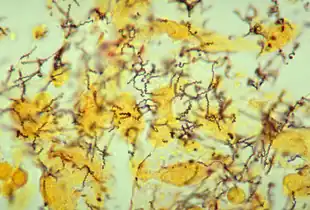| Treponema | |
|---|---|
 | |
| Treponema pallidum spirochaetes | |
| Scientific classification | |
| Domain: | Bacteria |
| Phylum: | Spirochaetota |
| Class: | Spirochaetia |
| Order: | Spirochaetales |
| Family: | Treponemataceae |
| Genus: | Treponema Schaudinn 1905 emend. Abt, Göker & Klenk 2013 |
| Type species | |
| Treponema pallidum (Schaudinn & Hoffmann 1905) Schaudinn 1905 | |
| Species[1] | |
|
See text | |
| Synonyms | |
| |
Treponema is a genus of spiral-shaped bacteria. The major treponeme species of human pathogens is Treponema pallidum, whose subspecies are responsible for diseases such as syphilis, bejel, and yaws. Treponema carateum is the cause of pinta.[2] Treponema paraluiscuniculi is associated with syphilis in rabbits.[3] Treponema succinifaciens has been found in the gut microbiome of traditional rural human populations.[4]
Phylogeny
The currently accepted taxonomy is based on the List of Prokaryotic names with Standing in Nomenclature (LPSN)[5] and National Center for Biotechnology Information (NCBI).[1]
| 16S rRNA based LTP_08_2023[6][7][8] | 120 marker proteins based GTDB 08-RS214[9][10][11] | |||||||||||||||||||||||||||||||||||||||||||||||||||||||||||||||||||||||||||||||||||||||||||||||||||||||||||||||||||||||||||||||||||||||||||||||||||||||||||||||||||||||||||||||||||||||||||||||||||||||||||||||||||||||||||||||||||||||||||||||||||||||||||||||||||||||||||||||||||||||||||||||||||||||||||||||||||||||||||||||||||||||||||||||||||||||||||||||||||||||||||||||||
|---|---|---|---|---|---|---|---|---|---|---|---|---|---|---|---|---|---|---|---|---|---|---|---|---|---|---|---|---|---|---|---|---|---|---|---|---|---|---|---|---|---|---|---|---|---|---|---|---|---|---|---|---|---|---|---|---|---|---|---|---|---|---|---|---|---|---|---|---|---|---|---|---|---|---|---|---|---|---|---|---|---|---|---|---|---|---|---|---|---|---|---|---|---|---|---|---|---|---|---|---|---|---|---|---|---|---|---|---|---|---|---|---|---|---|---|---|---|---|---|---|---|---|---|---|---|---|---|---|---|---|---|---|---|---|---|---|---|---|---|---|---|---|---|---|---|---|---|---|---|---|---|---|---|---|---|---|---|---|---|---|---|---|---|---|---|---|---|---|---|---|---|---|---|---|---|---|---|---|---|---|---|---|---|---|---|---|---|---|---|---|---|---|---|---|---|---|---|---|---|---|---|---|---|---|---|---|---|---|---|---|---|---|---|---|---|---|---|---|---|---|---|---|---|---|---|---|---|---|---|---|---|---|---|---|---|---|---|---|---|---|---|---|---|---|---|---|---|---|---|---|---|---|---|---|---|---|---|---|---|---|---|---|---|---|---|---|---|---|---|---|---|---|---|---|---|---|---|---|---|---|---|---|---|---|---|---|---|---|---|---|---|---|---|---|---|---|---|---|---|---|---|---|---|---|---|---|---|---|---|---|---|---|---|---|---|---|---|---|---|---|---|---|---|---|---|---|---|---|---|---|---|---|---|---|---|---|---|---|---|---|---|---|---|---|---|---|---|---|---|---|---|---|---|---|---|---|---|---|---|---|---|---|---|---|---|---|---|---|---|---|
|
|
Unassigned species:
- "Ca. Treponema caballi" Gilroy et al. 2022
- Treponema calligyrum Noguchi 1913
- Treponema carateum Brumpt 1939 (pinta-causing Treponema)
- "Ca. T. equi" Gilroy et al. 2022 non (Novy & Napp 1906) Noguchi 1928
- "Ca. T. equifaecale" Gilroy et al. 2022
- "Ca. Treponema faecavium" Gilroy et al. 2021
- "Ca. T. intracellulare" Ohkuma et al. 2015 corrig. Oren et al. 2020
- "T. legeri" (Duboscq & Lebailly 1912) Zuelzer 1925
- "T. macrodentium" Noguchi 1912
- "Ca. T. merdequi" Gilroy et al. 2022
- Treponema paraluisleporis Lumeij et al. 1994
- Treponema pertenue (Castellani 1905) Castellani & Chalmers 1910
- Treponema refringens (Schaudinn and Hofmann 1905) Castellani and Chalmers
- "Ca. T. scatequi" Gilroy et al. 2022
- "Treponema scoliodonta" (Hoffmann 1920) Noguchi 1928 ex Smibert 1984
- "Ca. Treponema suis" Molbak et al. 2006 non Kujumgiev & Spassova 1967
- "Ca. Treponema teratonymphae" Noda et al. 2018
- "T. trimerodonta" (Hoffmann 1920) Prévot 1940
The species Treponema hyodysenteriae and Treponema innocens have been reclassified into Serpulina hyodysenteriae and Serpulina innocens.[12]
See also
References
- 1 2 Sayers; et al. "Treponema". National Center for Biotechnology Information (NCBI) taxonomy database. Retrieved 2023-03-20.
- ↑ Antal GM, Lukehart SA, Meheus AZ (January 2002). "The endemic treponematoses". Microbes Infect. 4 (1): 83–94. doi:10.1016/S1286-4579(01)01513-1. PMID 11825779.
- ↑ Harper KN, Liu H, Ocampo PS, et al. (August 2008). "The sequence of the acidic repeat protein (arp) gene differentiates venereal from nonvenereal Treponema pallidum subspecies, and the gene has evolved under strong positive selection in the subspecies that causes syphilis". FEMS Immunol. Med. Microbiol. 53 (3): 322–32. doi:10.1111/j.1574-695X.2008.00427.x. PMID 18554302.
- ↑ Angelakis E, Bachar D, Yasir M, Musso D, Djossou F, Gaborit B, et al. (January 2019). "Treponema species enrich the gut microbiota of traditional rural populations but are absent from urban individuals". New Microbes and New Infections. 27: 14–21. doi:10.1016/j.nmni.2018.10.009. PMC 6276622. PMID 30555706.
- ↑ J.P. Euzéby. "Treponema". List of Prokaryotic names with Standing in Nomenclature (LPSN). Retrieved 2023-03-20.
- ↑ "The LTP". Retrieved 20 November 2023.
- ↑ "LTP_all tree in newick format". Retrieved 20 November 2023.
- ↑ "LTP_08_2023 Release Notes" (PDF). Retrieved 20 November 2023.
- ↑ "GTDB release 08-RS214". Genome Taxonomy Database. Retrieved 10 May 2023.
- ↑ "bac120_r214.sp_label". Genome Taxonomy Database. Retrieved 10 May 2023.
- ↑ "Taxon History". Genome Taxonomy Database. Retrieved 10 May 2023.
- ↑ Stanton TB, Jensen NS, Casey TA, Tordoff LA, Dewhirst FE, Paster BJ (January 1991). "Reclassification of Treponema hyodysenteriae and Treponema innocens in a new genus, Serpula gen. nov., as Serpula hyodysenteriae comb. nov. and Serpula innocens comb. nov". Int. J. Syst. Bacteriol. 41 (1): 50–8. doi:10.1099/00207713-41-1-50. PMID 1704792.